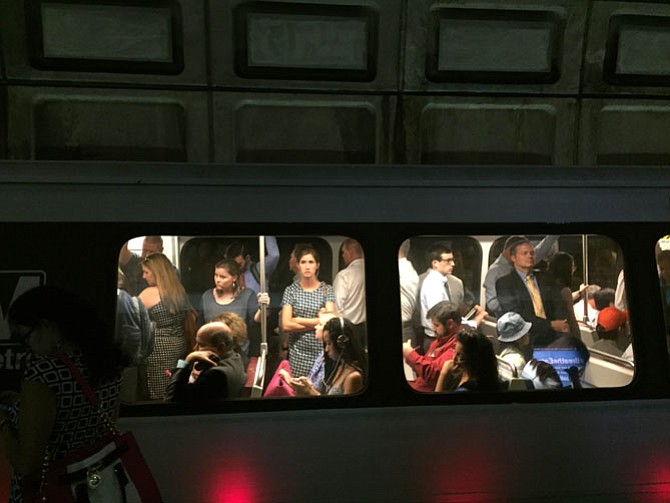Westbound Orange Line train. Photo by Vernon Miles.
Surge 5 ended with a bang. On Friday, July 29, a Metro train derailed near the East Falls Church Metro Station. Two passengers sustained minor injuries and a third was sent to the hospital for a non-life threatening head wound. The Arlington portions of the Orange and Silver lines had already been single tracking as part of Surge 5, but the derailment closed the lines between Ballston and McLean on the Silver Line and West Falls Church on the Orange Line until Monday, when Surge 5 was scheduled to have finished.
“Friday was a complete disaster for the region,” said Gov. Terry McAuliffe on Aug. 1 at a groundbreaking ceremony for I-66 improvements. “How does that even happen?”
In a press release, the Washington Metropolitan Area Transit Authority (WMATA) said a “wide gauge” caused the derailment, a situation where the tracks are too far apart and the wheels lose contact with the rails.
“Friday was tough,” said Arlington Deputy Director of Transportation Dennis Leach. “We’re lucky we’re in the middle of the summer and weekend ridership is low … It was a hardship for our riders. It limits our travel options. If you have to have a derailment though, having it over a weekend is better than middle of the week.”
It was a dramatic end to a surge that had otherwise been without incident. Surge 5 was the latest in a series of single-tracking and shutdowns to Metro lines over the summer while WMATA makes repairs to the metro infrastructure. All five surges so far have taken place around Arlington and Alexandria, forcing local governments to make changes to the local transportation networks. In Arlington and Alexandria, those changes have been added bikeshare stations and increased bus line services.
“All those things worked out pretty well,” said Leach, “weekend derailment aside.”
Leach said that there was very little Arlington could do on short notice to ease the effects of the derailment. The county could plan ahead for the surges, but Leach said after the derailment the county could only react.
During Surge 5, Arlington offered added bus capacity on routes parallel to the Orange and Silver lines as well as new service hours for the bus between Crystal City and the Rosslyn Courthouse. The final data on how successful those plans were hasn’t been released yet; Leach says that report will be prepared before the end of the week, but data from previous surges indicate an increased use of buses and other forms of transportation.
Surge 4 was a complete Blue and Yellow Line segment shutdown between National Airport and Pentagon City with no Metrorail service at Crystal City. ART 43, a bus line that runs parallel to the blue line, doubled its ridership from 620 passengers during weekdays in May to 1,240 riders during Surge 4. During Surge 1, where Orange and Silver Line trains were single tracking between East Falls Church and Ballston, Metrobus routes saw 14-45 percent increase in ridership, while the ART 55 route along Lee Highway saw a more modest 2-13 percent increase.
Arlington also changed the curbside management of buses at the East Falls Church and Ballston Metro to create more curb and road spaces for buses. In Ballston, the changes took over street metered parking to expand the bus spaces. Leach says these changes were temporary. But other changes, like the expanded bike share station at Ballston, will remain.
“What we learned in surge one is that our ridership base is pretty resilient,” said Leach. “If you get information out, people will use the alternative.”
On Aug. 1, the first day back to normal service, many commuters said they did have to find alternative means of getting to work during a surge.
“I’d start on the Silver Line in Reston waiting 45 minutes for a train which, when it shows up, is full,” said Nick LaBahn. “They you get into Rosslyn and we had to wait for two and a half hours. Eventually I just gave up and started working from home.”
Working from home was one of the most common solutions for Arlington commuters. Dillon Simon said he planned his summer vacations to avoid the surges.
“Between vacation and telework, it was OK,” said Simon. “The main delay was the Yellow Line closing in Alexandria.”
Mike Navarro is an Alexandria resident who had just returned to the area from El Paso when the surges hit. Navarro said the worst part of the surges was seeing buses lined up to take people from one station or another, then seeing some of the buses unexpectedly pull away to change shifts or take a break. But overall, Navarro said he was impressed with the bus system.
“The buses were pretty good,” said Navarro. “We had very courteous drivers and they knew their stuff. I think I would use the buses more after this.”
“I thought the buses did a good job,” said Lena Chang, who takes the Yellow Line to L’Enfant Plaza. “We had to take the shuttle buses, but they were pretty well organized. The commute was longer, it’s usally about 30 minutes and during the surge it took an hour and 15 minutes, but they had people directing buses and the shuttles were ready to go.”
Arlington County Board Chair Libby Garvey said her hope is, after the surges, more Metro riders will start to transition into bus riders.
“So far so good for safe tracking,” said Garvey. “Our bus ridership has doubled, we’ve seen people are using alternative modes of transit. I totally suspect that people will switch over to buses after this.”
The next surge to hit Arlington will be Surge 11, between Nov. 3 and 11 where the Orange and Silver Lines will be continuously single tracking. For Arlingtonians using the Metro, Leach says Surge 11 should be virtually identical to Surge 5.


